 |
 |
 |
 |
| Fieldfares (but no starling, as shown here: we didn't
see a starling all day) |
Redwing, another winter thrush that we haven't seen
such a lot of this year |
A mistle thrush (a resident but feeding alongside the
migrant thrushes) |
Crows, of course |
 |
 |
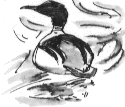 |
 |
| Gadwall |
Goldeneye |
Goosander |
Greenfinch |
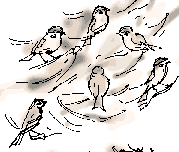 BOXING
DAY means that it's a birding day with my friends David
(from Cumbria) and John (from Plymouth). I don't often
go out looking specifically for birds at any other time of year. BOXING
DAY means that it's a birding day with my friends David
(from Cumbria) and John (from Plymouth). I don't often
go out looking specifically for birds at any other time of year.
Terrington
My dad used to go out after birds on Boxing Day, but he used
to shoot them, at least he shot pheasants, partridge, wood pigeons, woodcock,
mallard and hare, at Terrington, on the other side of
York, not far from Helmsley and Castle Howard. Boxing Day was the big
meeting of all the guns who contributed to the shoot. The gamekeeper at
the time was Fred Green. I remember the smell of the gamy pheasants hanging
from a hook on the shelves in the store room, the spatters of blood on
the red-painted concrete floor. Terrington, which also boasted a bit of
fishing on a small dam, provided the subject for one of my early attempts
at writing a nature diary.
The Road to Anglers
After about 25 years of (non-lethal) Birding Boxing Days with my friends,
this morning must be the best for species ticked off before we even get
out of the car. This is thanks to a stubbly field 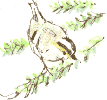 we
pass on the way which has attracted thirty or forty wintering thrushes
and the opportunity we have to pull up on the lane that crosses an arm
of Wintersett Reservoir, giving views through the hawthorn
hedges of open water to our left and a reed-fringed backwater to our right,
but the highlight is 15 or 20 tree sparrows crowded onto
a bird table in front of our space in the car park at Anglers
Country Park. Tree sparrow numbers have declined over the last
ten years, so it's good to see so many here. we
pass on the way which has attracted thirty or forty wintering thrushes
and the opportunity we have to pull up on the lane that crosses an arm
of Wintersett Reservoir, giving views through the hawthorn
hedges of open water to our left and a reed-fringed backwater to our right,
but the highlight is 15 or 20 tree sparrows crowded onto
a bird table in front of our space in the car park at Anglers
Country Park. Tree sparrow numbers have declined over the last
ten years, so it's good to see so many here.
On our walk around Haw Park we get excellent views of
goldcrests, in loose groups of about 4 or 5, alongside
more numerous coal tits, making their way through the
branches of conifers and birches. I realise after the views I had today
that my previous sketch of a goldcrest, drawn from memory, was incorrect;
there should be yellow stripe along the top of the head. The coal tit
has a white stripe on its head like that. Memory plays strange tricks!
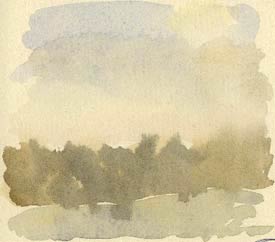 |
4.10 p.m., Coxley Valley
 'You
haven't done much drawing this morning,' comments David (who
took the photograph of me, right, on Christmas Eve). 'You
haven't done much drawing this morning,' comments David (who
took the photograph of me, right, on Christmas Eve).
No I haven't; I find that I don't draw much while out birdwatching,
unless we end up in a hide for some time. Most of the time
we're ambling along, checking out every duck and dunnock,
at the pace of a leisurely supermarket stroll, while my natural
rythym is either to be striding out, my mind in free-fall,
experiencing the landscape unfolding as I walk or, in complete
contrast, to stop and look, and look, and look; and, while
it might be a bird I'm drawing, it might just as
easily be a mossy boulder, a tree root or a patch of weedy
turf.
But you can't say to your birding companions; 'Do you mind
if we stop here for 45 minutes because I've just seen a particularly
fascinating patch of weedy turf?'
But I agree with David that I have been remiss today, so,
as has happened so many times in the past, when I realise
that the daylight is fading, I get my watercolours together
- the big box of White Nights Russian watercolours
this time - and paint, in a few minutes, the sky, wood and
meadow. |
|
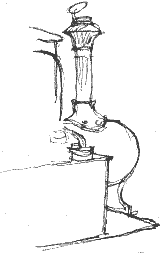 Ross Ross
Boxing Day, Sunday, but there's a very regular train service; at least
there is in Thornes Park, Wakefield. David's dad, Jeffrey
Stubbs, is the driver of Ross, a miniature steam engine
which he built himself; a half-size replica of a Welsh mountain railway
narrow-gauge tank engine (at least that's what it looks like to me).
I love the smell of steam. It's amazing that an engine the size of an
average fridge has the power pull along 3 or 4 bench-like trucks and 20
or 30 passengers. Most engineering these days is boxed-in; I like the
way that form and function are so obvious in a steam engine.
 Wish
they'd install a little restaurant car on the train. Wish
they'd install a little restaurant car on the train.
'How many locomotives has your dad made?' I ask David.
'Twenty-two, but he started in his teens.'
David makes Solway Dory sailing canoes (see below).

Link
Solway Dory
Richard Bell, richard@willowisland.co.uk
|